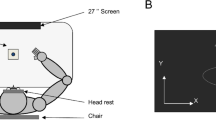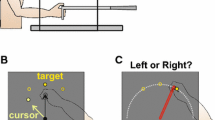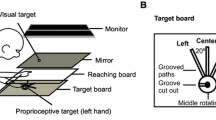Abstract
When reaching towards objects, the human central nervous system (CNS) can actively compensate for two different perturbations simultaneously (dual adaptation), though this does not simply occur upon presentation. Dual adaptation is made more difficult when the desired trajectories and targets are identical and hence do not cue the impending perturbation. In cases like these, the CNS requires contextual cues in order to predict the dynamics of the environment. Not all cues are effective at facilitating dual adaptation. In two experiments, we investigated the efficacy of two contextual cues that are intrinsic to the CNS, namely hand as well as body posture in concurrently adapting to two opposing visuomotor rotations. For the hand posture experiment, we also look at the role of extended training. Participants reached manually to visual targets with their unseen hand represented by a cursor that was rotated either 30° clockwise or counterclockwise, determined randomly on each reach. Each rotation was associated with a distinct hand posture (a precision or power grip, respectively) in one experiment and a distinct body rotation (10° leftward or rightward turn of the seat, respectively, while fixating straight) in the second experiment. Critically, the targets (and thus, the required cursor trajectories) were identical in both rotations. We found that how people held the tool or oriented their body while reaching is sufficient for concurrently adapting separate visuomotor mappings such that over time, reach errors significantly decrease. Extended practice did not lead to further benefits though. These findings suggest that when the required cursor movements are identical for different visuomotor mappings, dual adaptation is still possible given sufficient intrinsic contextual cues.







Similar content being viewed by others
References
Baldeo R, Henriques D (2013) Dual adaptation to opposing visuomotor rotations with similar hand movement trajectories. Exp Brain Res 227(2):231–241
Balitsky Thompson AK, Henriques DY (2010) Visuomotor adaptation and intermanual transfer under different viewing conditions. Exp Brain Res 202(3):543–552
Baraduc P, Wolpert DM (2002) Adaptation to a visuomotor shift depends on the starting posture. J Neurophysiol 88(2):973–981
Brashers-Krug T, Shadmehr R, Bizzi E (1996) Consolidation in human motor memory. Nature 382(6588):252–255. doi:10.1038/382252a0
Caithness G, Osu R, Bays P, Chase H, Klassen J, Kawato M, Flanagan JR (2004) Failure to consolidate the consolidation theory of learning for sensorimotor adaptation tasks. J Neurosci 24(40):8662–8671. doi:10.1523/JNEUROSCI.2214-04.2004
Cothros N, Wong J, Gribble PL (2008) Distinct haptic cues do not reduce interference when learning to reach in multiple force fields. PLoS One 3(4):e1990. doi:10.1371/journal.pone.0001990
Cothros N, Wong J, Gribble PL (2009) Visual cues signaling object grasp reduce interference in motor learning. J Neurophysiol 102(4):2112–2120
Dionne JK, Henriques DY (2008) Interpreting ambiguous visual information in motor learning. J Vis 8(15):1–10
Donchin O, Francis JT, Shadmehr R (2003) Quantifying generalization from trial-by-trial behavior of adaptive systems that learn with basis functions: theory and experiments in human motor control. J Neurosci 23(27):9032–9045
Dumontheil I, Panagiotaki P, Berthoz A (2006) Dual adaptation to sensory conflicts during whole-body rotations. Brain Res 1072(1):119–132
Galea JM, Miall RC (2006) Concurrent adaptation to opposing visual displacements during an alternating movement. Exp Brain Res 175(4):676–688
Gandolfo F, Mussa-Ivaldi FA, Bizzi E (1996) Motor learning by field approximation. Proc Natl Acad Sci USA 93(9):3843–3846
Gupta R, Ashe J (2007) Lack of adaptation to random conflicting force fields of variable magnitude. J Neurophysiol 97(1):738–745
Haruno M, Wolpert DM, Kawato M (2001) Mosaic model for sensorimotor learning and control. Neural Comput 13(10):2201–2220
Hegele M, Heuer H (2010) Implicit and explicit components of dual adaptation to visuomotor rotations. Conscious Cogn 19(4):906–917
Hinder MR, Woolley DG, Tresilian JR, Riek S, Carson RG (2008) The efficacy of colour cues in facilitating adaptation to opposing visuomotor rotations. Exp Brain Res 191(2):143–155
Hirashima M, Nozaki D (2012) Distinct motor plans form and retrieve distinct motor memories for physically identical movements. Curr Biol 22(5):432–436. doi:10.1016/j.cub.2012.01.042
Karniel A, Mussa-Ivaldi FA (2002) Does the motor control system use multiple models and context switching to cope with a variable environment? Exp Brain Res 143(4):520–524. doi:10.1007/s00221-002-1054-4
Kawato M (1999) Internal models for motor control and trajectory planning. Curr Opin Neurobiol 9(6):718–727
Krakauer JW, Ghilardi MF, Ghez C (1999) Independent learning of internal models for kinematic and dynamic control of reaching. Nat Neurosci 2(11):1026–1031
Krakauer JW, Mazzoni P, Ghazizadeh A, Ravindran R, Shadmehr R (2006) Generalization of motor learning depends on the history of prior action. PLoS Biol 4(10):e316
Krakauer JW, Pine ZM, Ghilardi M, Ghez C (2000) Learning of visuomotor transformations for vectorial planning of reaching trajectories. J Neurosci 20(23):8916–8924
Krouchev NI, Kalaska JF (2003) Context-dependent anticipation of different task dynamics: rapid recall of appropriate motor skills using visual cues. J Neurophysiol 89(2):1165–1175
Osu R, Hirai S, Yoshioka T, Kawato M (2004) Random presentation enables subjects to adapt to two opposing forces on the hand. Nat Neurosci 7(2):111–112
van Werner S, Aken BC, Hulst T, Frens MA, van der Geest JN, Struder HK, Donchin O (2015) Awareness of sensorimotor adaptation to visual rotations of different size. PLoS One 10(4):e0123321. doi:10.1371/journal.pone.0123321
Wang L, Musseler J (2014) Concurrent adaptation to opposite visual distortions: impairment and cue. Psychol Res 78(4):453–464. doi:10.1007/s00426-013-0500-1
Wolpert DM, Ghahramani Z (2000) Computational principles of movement neuroscience. Nat Neurosci 3(Suppl):1212–1217
Woolley DG, Tresilian JR, Carson RG, Riek S (2007) Dual adaptation to two opposing visuomotor rotations when each is associated with different regions of workspace. Exp Brain Res 179(2):155–165
Woolley DG, de Rugy A, Carson RG, Riek S (2011) Visual target separation determines the extent of generalisation between opposing visuomotor rotations. Exp Brain Res 212(2):213–224
Acknowledgments
Thanks to Priyanka Sharma for her assistance with data collection. This work was supported by the Natural Sciences and Engineering Research Council (Denise Y. P. Henriques) and the German Research Foundation (DFG) under Grant No. HA 6861/2-1 (Bernard Marius ‘t Hart).
Author information
Authors and Affiliations
Corresponding author
Ethics declarations
Conflict of interest
The authors declare no conflict of interest.
Rights and permissions
About this article
Cite this article
Ayala, M.N., ‘t Hart, B.M. & Henriques, D.Y.P. Concurrent adaptation to opposing visuomotor rotations by varying hand and body postures. Exp Brain Res 233, 3433–3445 (2015). https://doi.org/10.1007/s00221-015-4411-9
Received:
Accepted:
Published:
Issue Date:
DOI: https://doi.org/10.1007/s00221-015-4411-9




